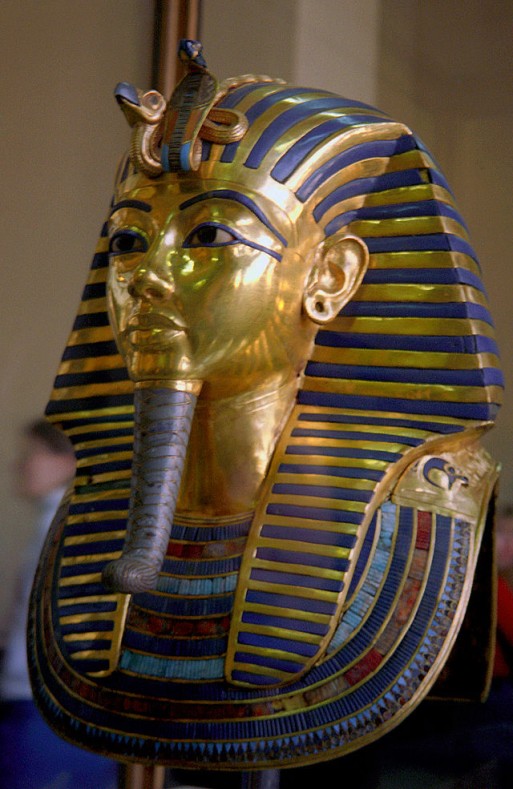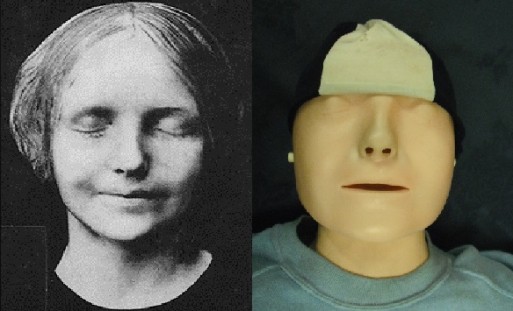
Credit: Wikipedia
The practice of creating death masks to remember those who have passed is a ritual that can be traced back to ancient Egypt and Rome. The most recognizable death mask comes from the tomb of Tutankhamun himself. The likeness of the ancient king was fashioned in beautiful gold and jewels, primarily as a means for the soul to identify its own body so that it could have a face in the afterlife.
In addition to this, death masks are a way for the living to reconnect with the past. Even in their earliest uses, which predated photography by thousands of years, these death masks, along with their ‘life mask’ counterparts were used by painters and sculptors as a means of capturing the truest impressions of the subject in their work. Oftentimes, these masks were reserved to be created as effigies for nobles, as was the case for the Roman emperor Julius Caesar, whose full wax body cast, complete with stab wounds, incited a public riot.
As death masks evolved from sculptures to casts, the stories that they share with the living grants viewers with an interesting look into the lives of the departed subjects. The exact nature of the casts allows onlookers a unique chance of experiencing history through the facsimile of the effigy. Medical science, in fact, was able to determine from Abraham Lincoln’s bronzed life mask, which was created in 1860, just a few years before his own death, that the former president was suffering from a fatal ‘wasting disease’ that may likely have killed him.
The exact nature of the casts allows onlookers a unique chance of experiencing history through the facsimile of the effigy.
Death masks and life masks have had a longstanding history in bringing aid to the scientific community. During the height of the pseudo-scientific fad of phrenology, death masks were often used as measurement tools to map out the brain of the subject. Likewise, in the medical community, both life and death masks were used as a means of documenting rare medical conditions that affect the face, as a means of studying their outward structure. Aside from this, the casts were also used in cases of forensic science, where casts could be taken to preserve and replicate fatal wounds to the head. This would be an invaluable process for cases that may otherwise go unsolved for years.
Death masks and life masks have had a longstanding history in bringing aid to the scientific community.
Perhaps the most famous death mask, that you may not realize you know, is that of L’Inconnue de la Seine. The mask itself was allegedly cast from a young girl in the 1880s, whose body was found in the Seine river in Paris after she took her life in despair because the love of her life had left her. While there is some contention as to whether this story rings true, as many have proposed that this was, instead, a life mask taken from a model, her legacy still goes on. To this day, the girl’s face is known as ‘the most kissed face of all time,’ after her mask was spotted by the Austrian doctor Peter Safar in 1960, who would go on to use her likeness, with a few modifications, as the first training CPR dummy.

Credit: Wikipedia
Although they are no longer prominent in today’s funerary traditions, death masks and life masks can still be appreciated in abundance at many museums around the world. These effigies serve as a strong bond that connects us to our history, and possibly even to our own ancestors. While many remain with us as beautiful pieces of art, we are left pondering about how their medical and forensic uses may have changed history and lives for the better.
Please let us know if you have had any experience with seeing a death mask in person. Perhaps you have even had the unique experience of meeting an ancestor face to face.
Related SevenPonds Articles:
- Ancient Egyptian Burial Customs: Tombs and Mummification
- A Man Immortal? Roman Funeral Sculptures
- Illuminating Death through Art

 Behind Death Masks: A History of How a Funeral Decoration Transformed Into a Tool to Improve Lives
Behind Death Masks: A History of How a Funeral Decoration Transformed Into a Tool to Improve Lives


 “Help Me, Helen”
“Help Me, Helen”
 Recovering Cremation Remains After the Los Angeles Fires
Recovering Cremation Remains After the Los Angeles Fires
 “As Tears Go By” by Marianne Faithfull
“As Tears Go By” by Marianne Faithfull














